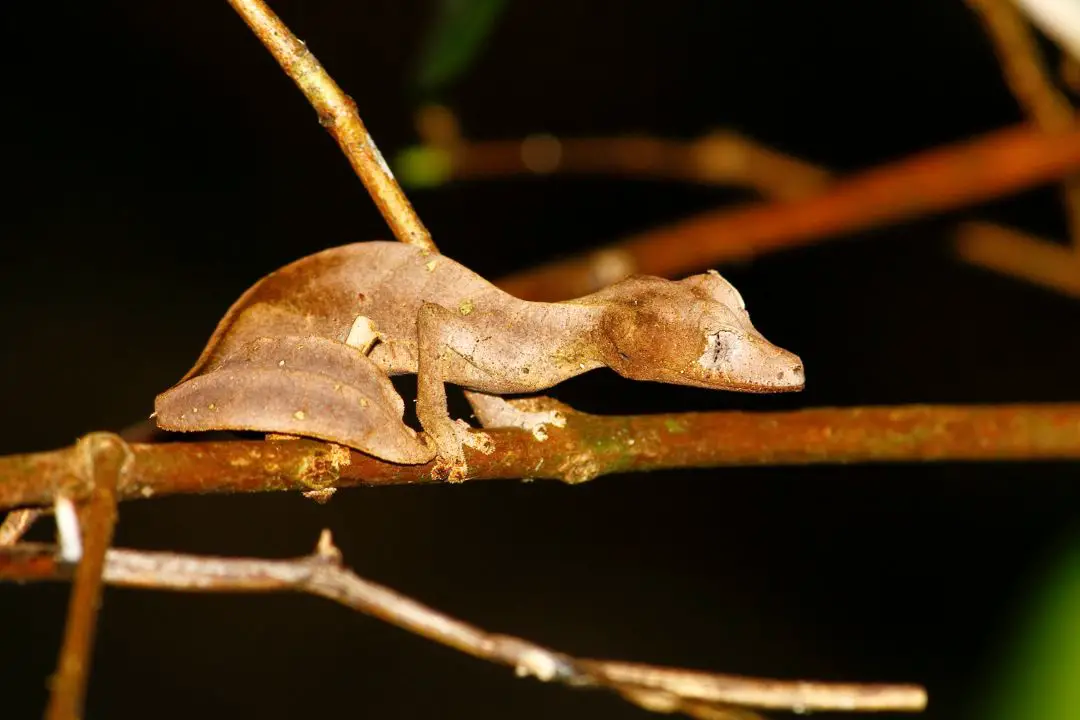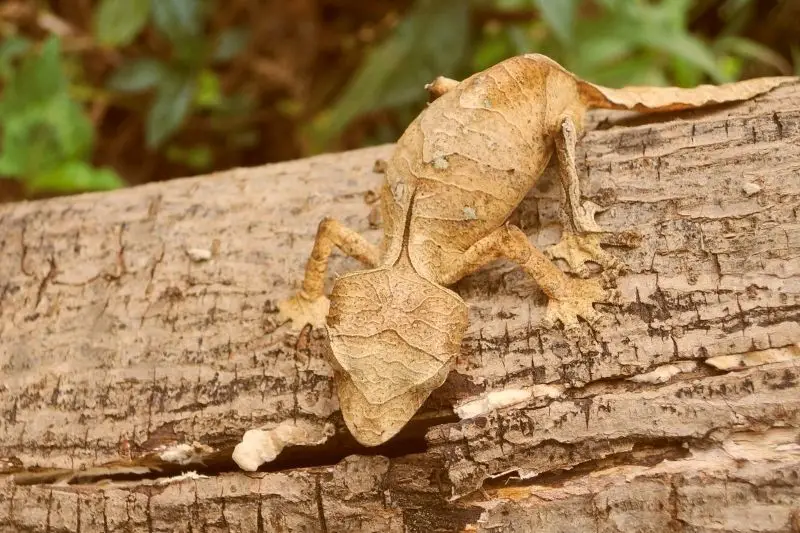The Satanic leaf-tailed gecko (Uroplatus phantasticus) is an unusual gecko native to the forests of southern Madagascar. These geckos are not recommended for beginners.
They have very particular care requirements, and they should not be handled. However, they can be rewarding pets for expert keepers.
These animals require more sensible care and are incredibly delicate compared to other geckos. Please ensure you have the experience needed to meet the species’ needs.
Their unusual appearance and climbing ability make them great to watch as they explore their enclosure.
This guide will teach you how to keep the species and what you need to help them thrive. This species can be challenging to find.
Since their wild population is threatened by habitat loss, try to find a captive-bred animal if you can.
Housing
Housing aims to create an enclosure that keeps your satanic leaf-tailed gecko happy and healthy. You need a safe enclosure that offers plenty of space is the right temperature and humidity and keeps stress to a minimum.
Enclosure
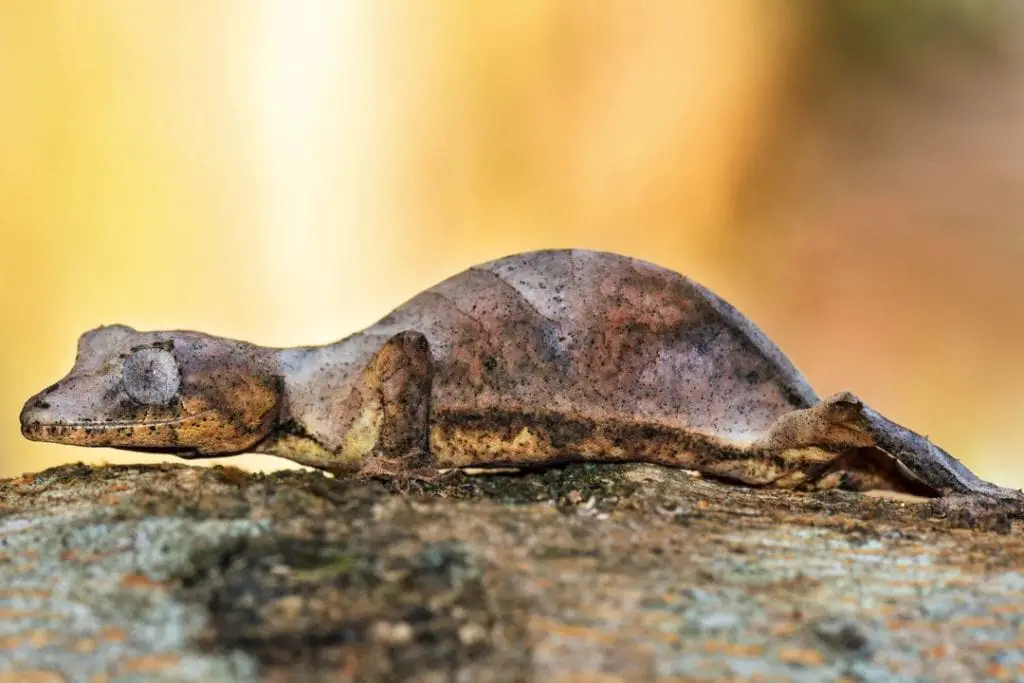
When looking for an enclosure, you must find one large enough for exercise. It should also allow your gecko to climb.
Glass enclosures are best since they offer an extra climbing area for your pet. PVC can also work if you struggle to keep heat or humidity.
If you are housing your pet alone, look for a minimum size of 18″x18″x18″.
If you didn’t find a perfectly square enclosure, I suggest looking for more horizontal room over vertical.
Satanic leaf-tailed geckos are arboreal, but they live close to the ground, where they can hide in dead leaves.
It should open from the front and offers plenty of glass to let your pet climb (this is an arboreal species). One thing to note for this particular leaf-tailed gecko is that you should not use a screen enclosure.
Screen enclosures can contribute to dehydration in this species.
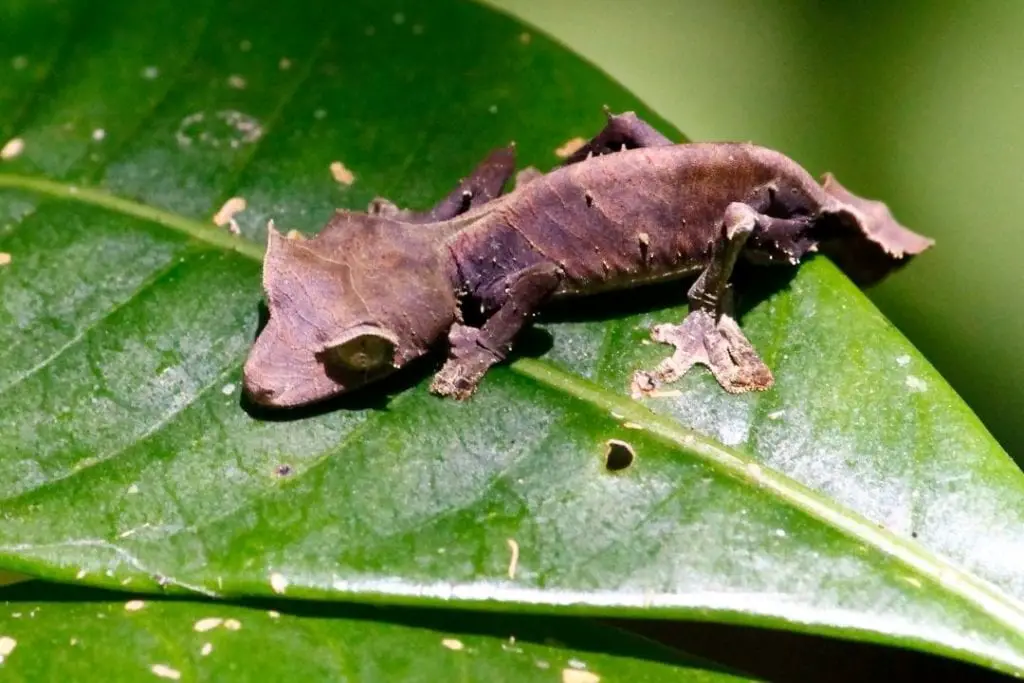
You can keep babies in a smaller enclosure as a hatchling until they can get around more easily, but most are sold when they are large enough to handle an adult enclosure.
Multiple Satanic Leaf Tailed Geckos in a Single Enclosure
You can house multiple leaf-tailed geckos together. You can keep groups of several so long as you only have one male per enclosure to avoid the occasional male – male aggression.
Be sure to add about 50% of the volume for each additional gecko.
Substrate
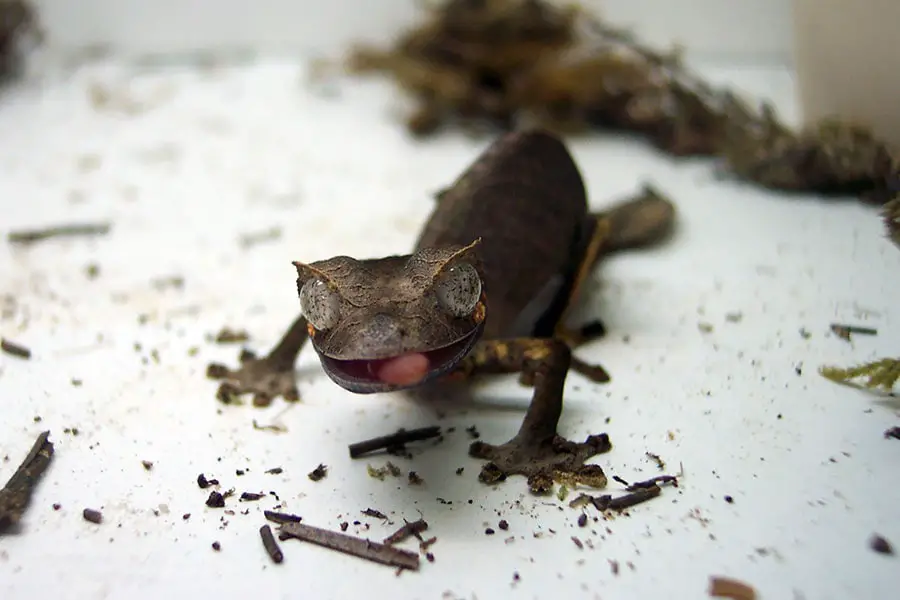
Satanic leaf-tailed geckos frequently leap after their prey. Your gecko can be injured if you do not have a soft substrate.
These geckos are small and delicate, so you should ensure the flooring is soft. You want a loose substrate with a small particle size.
It should also retain humidity.
You can create a safe DIY tropical mix with 60% organic topsoil and 40% peat moss or coconut fiber.
You can also use Zoo Med Reptisoil, Lugarti Natural Reptile Bedding, or The Bio Dude Terra Fauna.
Top Layer (Highly Recommended)
I highly suggest adding a layer of leaf litter or moss to the surface of the substrate. It provides more padding and helps keep your gecko from eating a mouthful of the substrate when it dives for a bug.
Dead leaves also help this species feel more secure. Remember, these are leaf mimics, and they love to feel hidden.
A bioactive enclosure is a great idea for all similar species since you need to go in the enclosure less often and don’t need to move the animal out as often.
Satanic leaf-tailed geckos frequently get a mouth full of the substrate if they miss their prey. While adults can pass these particles, babies cannot.
Keep hatchlings on paper towels, blue shop towels, or butcher paper until they are large enough for a natural substrate. Paper towels are not suitable for adults since they don’t offer enough padding and degrade rapidly in high humidity.
Never use any bark or chip substrate. Phantasticus geckos Owners have reported members of this genus that are of a similar side dying after ingesting bark or chip substrates.
They cannot pass larger pieces and pass away. Anything with pine or cedar is out since it is dangerous for reptiles. Any rigid substrate will not provide enough cushion when your gecko jumps after its prey.
Finally, reptile carpets can snag and injure the toes of geckos.
Temperature & Heating
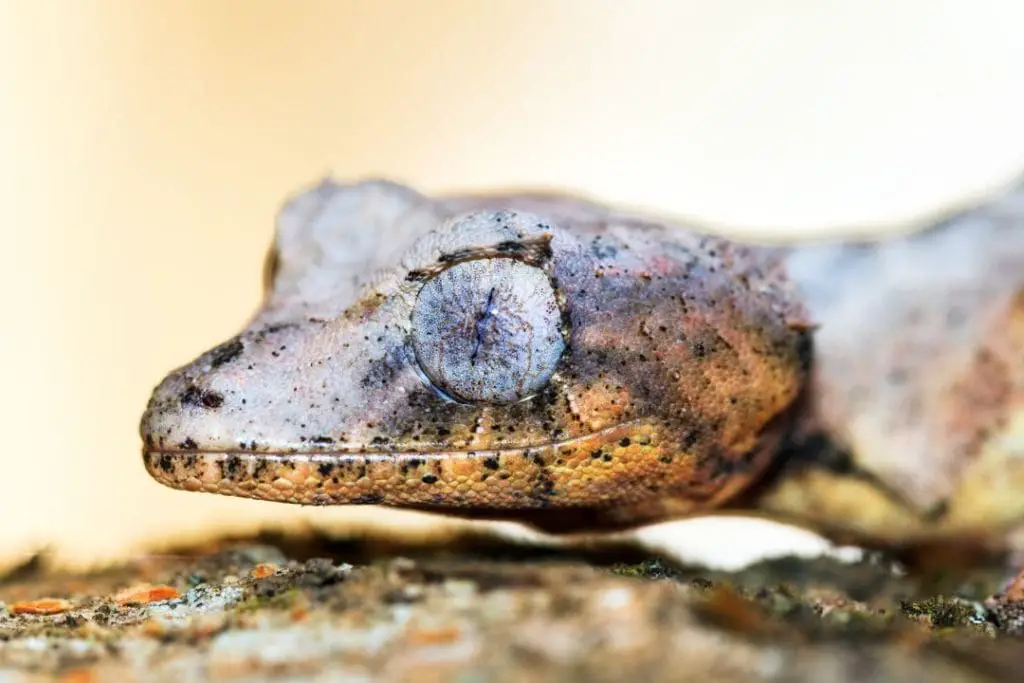
Satanic leaf-tailed geckos rely on outside temperatures to regulate their own body temperature. You need to establish a thermal gradient so your pet can easily thermoregulate.
You will want to create a basking area, a warm and cool side of the enclosure.
Place a probe from a digital thermometer in the hiding areas on the warm and cool sides. The basking area should be created with a white 25w basking light in an 18″ terrarium hood.
This can fit both your heating bulb and the UV bulb.
Ensure the top basking branch or vine is at least 4 inches from the bulb.
Use an infrared temperature gun to ensure the basking spot is at 80-85 degrees.
If you notice the enclosure heating up too much, use a weaker bulb or choose a dome fixture on a dimmer.
Correct Temperature Gradient for a Satanic Leaf-Tailed Gecko
The warm side should be 68-77 degrees, and the cool side should be 65-68 degrees.
The heating should also be on a timer. Leave both heating and UVB on for 12 hours a day.
You can let the temperature drop to 65-68 degrees at night. Suppose your enclosure regularly drops below this at night. In that case, you can consider shallow supplemental heating such as a heat mat on a thermostat or a ceramic heat emitter in a separate fixture.
With this arboreal species, the gradient is vertical, so keep this in mind when designing the enclosure and heating.
Small enclosures for juveniles can be hard to offer a basking spot.
Satanic leaf-tailed geckos can overheat easily, so monitor temperatures and watch your gecko closely for signs of overheating like gaping or erratic behavior.
Lighting
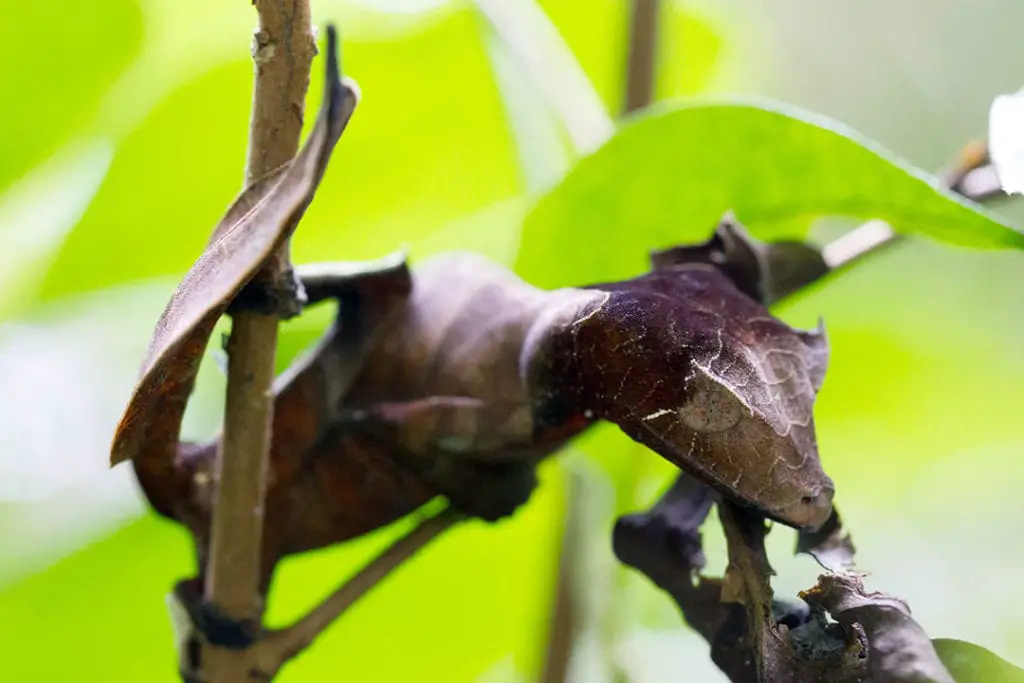
Since satanic leaf-tailed geckos are so sensitive, it is best to offer UVB to keep them healthy. They are very prone to both metabolic bone disease and over-supplementation.
As such, I highly suggest UVB for phantasticus geckos. Replace it yearly at least, but every 6 months is safer.
The Zoo Med ReptiSun 5.0 26w works well and has been measured for easy placement. You should place the basking area slightly over 4 inches away from the light.
The instructions can help you place the basking area properly. These geckos are crepuscular, but they will also be active at night. Remember to ensure the UV is on a timer as well.
The terrarium hood recommended for heating works very well for this species. However, you can also buy a separate fixture if you use a dome for the heating instead.
Enclosure Design and Shelter
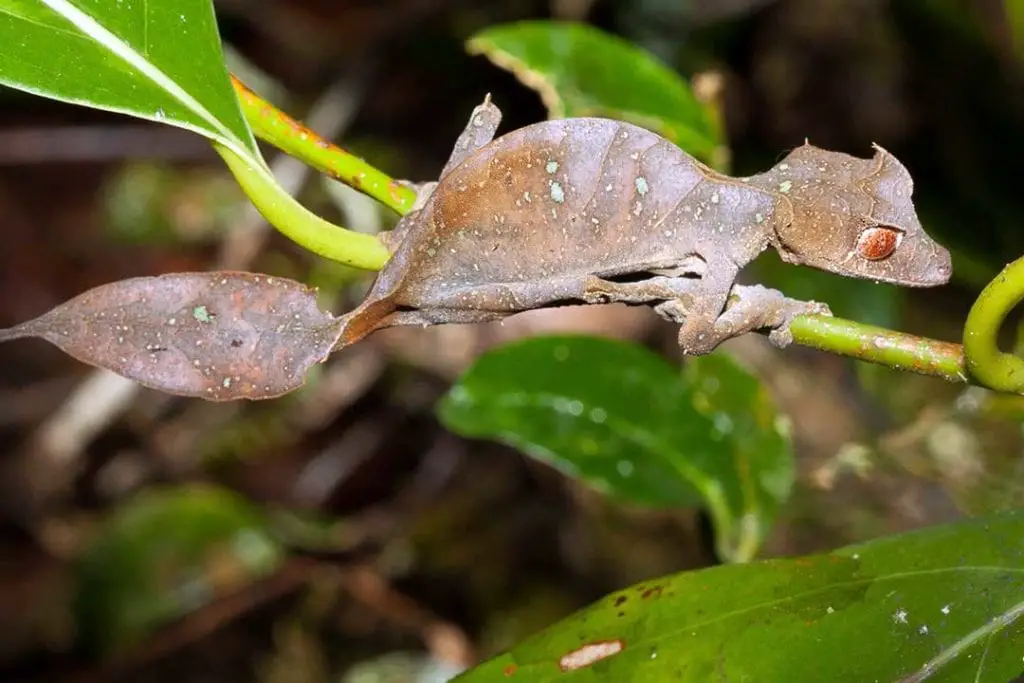
Since these are arboreal animals, they need plenty of space to climb. If your enclosure is not glass, you must add an extra climbing area so your pet can get enough exercise.
You can provide proper hides that are suspended at different levels of the enclosure. However, you can also provide extra shelter with real or artificial plants.
For this species, leaves can help them feel safer since they will be better camouflaged, and their tail resembles dead leaf.
Dead or brown leaves are great for this since this species will spend time closer to the forest floor where there are typically more dead leaves to let the gecko blend into its surroundings.
Artificial vines can be places you like and live plants can be trained.
Cork bark, maple, birch, and bamboo make great climbing structures for leaf-tailed geckos. You can use PVC pipes if you need to quarantine your new gecko.
You can use potted organic plants even if you don’t choose a bioactive setup. Always clean the leaves before placing the plant in the enclosure.
Your gecko will drink from the leaves, so the plants need to be cleaned. Live plants also help raise the humidity; if you use artificial plants, be sure you wash the plants in hot water. Dyes and residue on the artificial plants can hurt your gecko.
If you go for a bioactive enclosure, look for plants that will allow your pet to access enough height. Overhanging leaves and other softer surfaces can help break any falls.
Satanic leaf-tailed geckos love to dive for prey, so you should take care that your pet won’t hit anything that could hurt it.
Ensure you have enough substrate and keep it loose, so your pet has some padding. I also advise adding leaf litter and moss to the surface of the substrate to help provide extra padding and avoid as much substrate ingestion as possible.
Water
Most of your gecko’s water will come from water it drinks off of plants and the walls of the enclosure. Satanic leaf-tailed geckos will also accept bowls of water.
You can use a gecko feeding ledge to hold a cup of water. A gecko feeding cup gives the perfect amount of water for a day.
Humidity
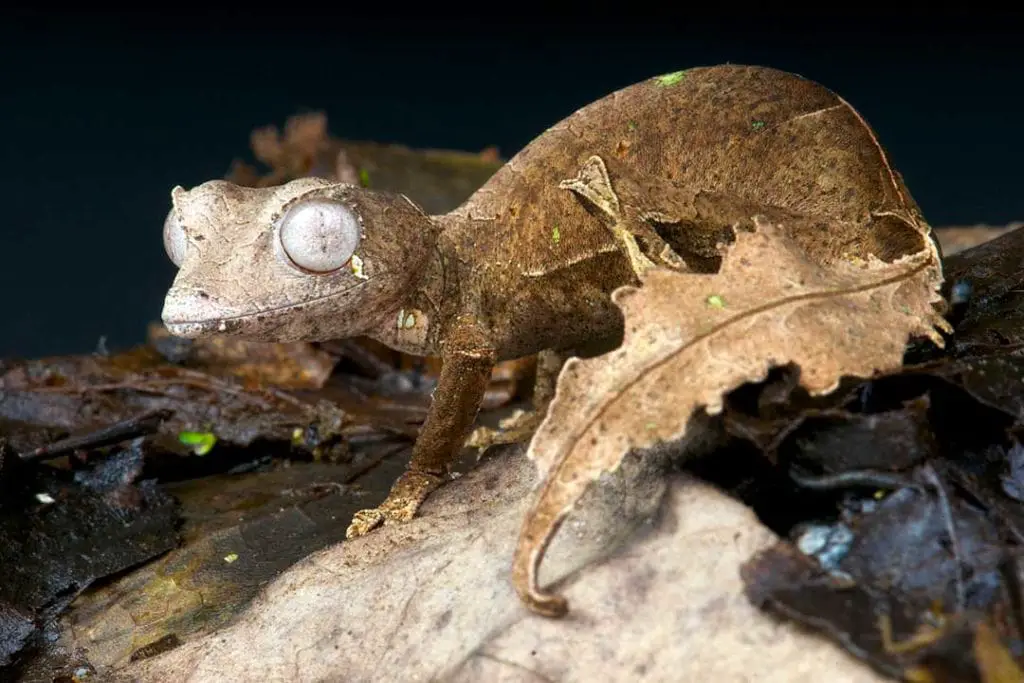
Humidity is important for the health of any reptile. The right humidity will keep your pet healthy and hydrated. It will also make sure your pet can shed its skink properly.
Remember, all reptiles need to shed. If the shed stays on, the gecko can be injured as the old skin shrinks.
This can even amputate toes or tails. For satanic leaf-tailed geckos, humidity is much more important for the animal’s health. The skin of this gecko is very thin.
They dehydrate quickly, and poor humidity will cause your pet’s condition to decline.
These little guys also experience heat stress quickly, so ensure all the conditions in the enclosure are right.
Correct humidity levels for a Satanic Leaf Tailed Gecko
During the day, the humidity should stay around 75-80% to mimic their natural rainforest habitat. At night, it should be 90-100%. The slightly drier conditions during the day help to replicate their natural habitat.
It also helps prevent mold. You will need to mist by hand with a pressure mister or invest in an automatic misting system.
I do not recommend using a fogger for this species. Misters allow for water drops to form throughout the enclosure. This allows your gecko to drink.
Foggers only raise the humidity. Never use cold water to mist, particularly if you are misting by hand. Lukewarm or warm water is better.
These are incredibly fragile animals, and cold water can stress them out. If you mist by hand, twice daily is the minimum. You may need to mist more often to keep the humidity stable.
Enclosure Maintenance
Keeping the enclosure clean is crucial for keeping such a fragile animal alive. You need to do spot cleans daily. If you can manage it, try to do so with the gecko still in the enclosure.
Make sure you clean up any waste and replace any soiled substrate. If you are using bioactive, you only need to remove larger pieces of waste.
You should also clean out any uneaten feeders daily. Take the time to wash out the water cup and give your pet more water. You will need to weigh your pet weekly and briefly check it for signs of illness or stuck shed.
Every few weeks, look closely to see if anything in the enclosure may need to be replaced.
If you are not using a bioactive enclosure, you should do a deep clean every 3 months. Place your gecko in a safe holding container with air holes for ventilation.
You will want to remove all the substrate and throw it away.
Clean the walls of the enclosure and any furnishings. Check things like branches and other pieces to ensure they are still clean.
Once everything has been cleaned and dried, you can add a new substrate. Place all the decorations back in the enclosure and turn the heating back on. Once it is warmed up, you can put your pet back.
Satanic Leaf-Tailed Gecko Diet
In the wild, this gecko eats a wide range of native insects. They tend to dive from their perches to catch their prey.
They are most active starting at dusk and may stay active at night.
Since these geckos are prone to nutritional deficiencies, you must watch what you feed them and how often. This study describes muscular degeneration caused by a vitamin E/selenium deficiency.
In captivity, they should be fed only appropriate insect prey that has been dusted with calcium powder.
Feeders
The best feeders for satanic leaf-tailed geckos are active prey they can chase.
These lizards will not reach dead prey. They hunt by the following movement. Ideal prey items are active and can climb to help catch the attention of your gecko.
Dubia roaches, crickets, grasshoppers, silkworms, and wax moths make excellent meals for your pet. Soft-shelled snails are also natural prey and the only one that doesn’t need to be dusted before feeding.
If you have breeding females, you should offer snails regularly. Try to vary the diet, but leaf-tailed geckos can be picky over prey.
Research what nutrient levels your feeders have and try to quickly balance the diet to correct any deficiencies. They may not take worms, but silkworms and hornworms are safe.
Be sure you don’t use a feeding cup or bowl. The hard cup can cause injuries to your eyelash leaf-tailed gecko when it leaps to catch its prey. Offer as many feeders as your pet can eat in a night.
This will take some trial and error. Prey should also be slightly smaller than the gecko’s head. Offer them in the evening after you mist; they tend to be more active and prefer night feeding.
If you add them before, you may wash off the calcium.
Supplements
Supplements are incredibly important for this species. Calcium is very important since the levels of calcium to phosphate in most insects are not healthy long-term.
If you offer UV like this guide advises, pick one without added D3. If you do, pick one without.
Since satanic leaf-tailed geckos are prone to having too much calcium, dust insects either every other feeding or once a week, you can check which is needed by looking at the calcium sacs on the roof of the bright red mouth.
Offer calcium more often if it is low. Any and all feeders should be gut-loaded before you offer them. You can buy pre-made food for your feeder insects.
However, you can also give your feeders things like kale, carrots, or sweet potatoes to add more nutrients for your gecko. Wheat germ, sweet potatoes, and spinach are all high in nutrients like vitamin E.
Ensure the feeders eat this no more than 24 hours before you offer them to your gecko. As for treats, save fatty feeders as a rare offering or if your gecko is too thin.
Feeding Frequency
Juvenile satanic should be fed daily. For adults, it can be tricky.
What keeps your gecko happy may not work for another. Your main goal is to keep your pet at a stable weight and body condition once it reaches adulthood.
Some keepers feed every other day, while some feed daily with one day of fasting a week. You could also release feeders into the enclosure once a week and let your gecko hunt them down.
Weigh your gecko weekly and use whatever method works best. I would suggest trying every other day to start and adjusting from there.
Shedding
All reptiles need to shed their old skin. this is important for growth and healing. Keep up the humidity to make sure your gecko can shed properly.
Offering a humid hide filled with damp sphagnum moss is a great way to offer more humidity as your gecko needs it. Check your gecko for stuck sheds during your weekly weighing and health check.
Handling and Body Language
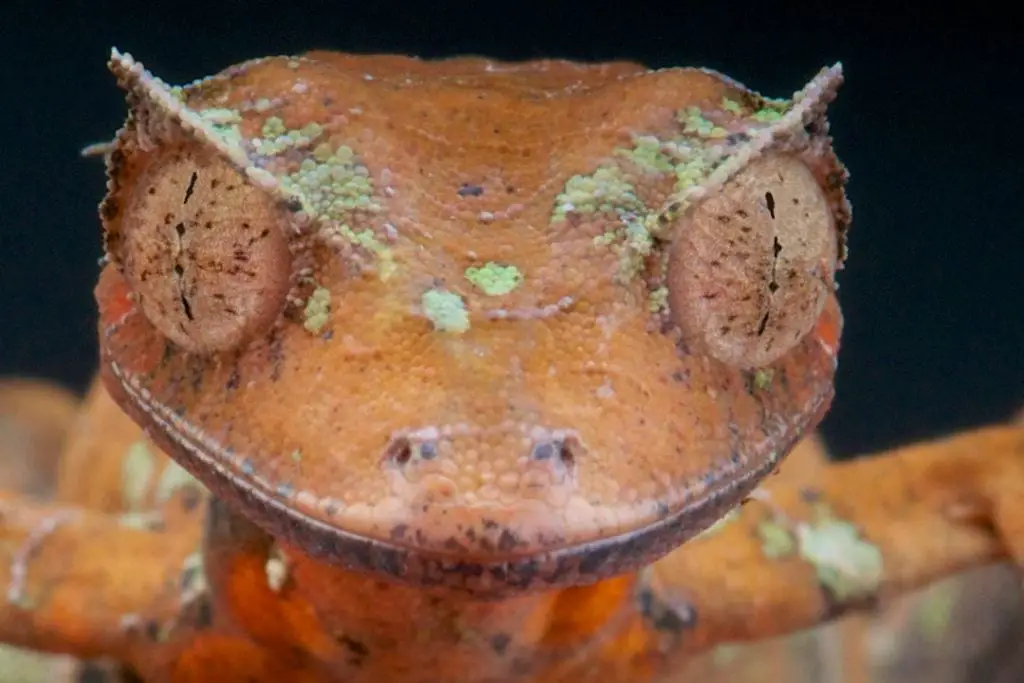
Since handling is so stressful, you should keep it to a minimum. Satanic leaf-tailed geckos are typically slow-moving and do not leap like other geckos.
A panicked gecko will move quickly and try to leap away. Keep stress to a minimum and only handle it when you must.
Watch for the gaping mouth, stiff body language, and an arched tail. This means your pet is terrified! Try to return them to the enclosure as quickly as possible while being safe.
This geckos genus has fun habits like vocalizations to communicate with other geckos, tail waving, and the famous bug stare.
If your gecko is scared, it may also scream with far more volume than you would expect from such a tiny creature.
Breeding
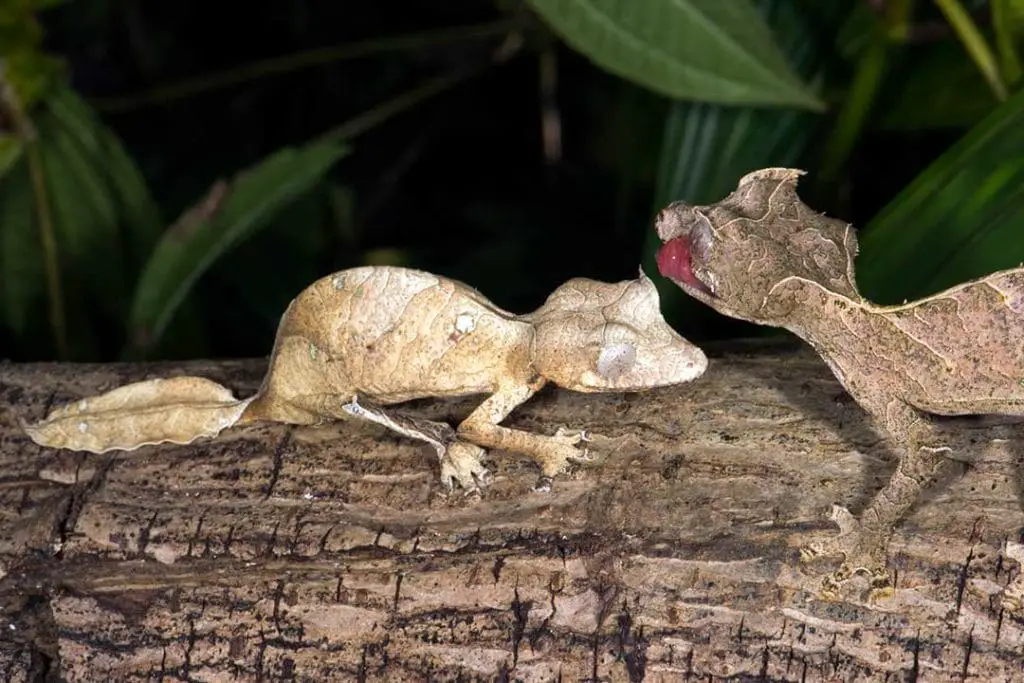
Breeding this species is very easy. If you house a breeding pair (male and female), they will breed independently.
Spherical eggs are typically laid in the substrate and hatch after 60-70 days in a proper enclosure. Females can lay up to 6 clutches of eggs and typically lay 2 at a time in leaf litter.
Female geckos possess a flat tail, and the tail of a male will become bulbous.
Frequently Asked Questions
This short section will teach you more about these great geckos. If your question isn’t answered here, please leave it below.
Genus Uroplatus Species
The Satanic Leaf-Tailed Gecko is part of a number of species sharing the genus Uroplatus:
- Uroplatus alluaudi – northern leaf-tail gecko
- Uroplatus ebenaui – spearpoint leaf-tail gecko
- Uroplatus fangorn
- Uroplatus fetsy
- Uroplatus fiera
- Uroplatus fimbriatus – common leaf-tail gecko
- Uroplatus finaritra
- Uroplatus finiavana
- Uroplatus fivehy
- Uroplatus fotsivava
- Uroplatus giganteus – giant leaf-tail gecko
- Uroplatus guentheri – Günther’s leaf-tail gecko
- Uroplatus henkeli – frilled leaf-tail gecko
- Uroplatus kelirambo
- Uroplatus lineatus – lined leaf-tail gecko
- Uroplatus malahelo
- Uroplatus malama
- Uroplatus phantasticus – satanic leaf-tail gecko / eyelash leaf tailed gecko
- Uroplatus pietschmanni – cork-bark leaf-tail gecko
- Uroplatus sameiti
- Uroplatus sikorae – mossy leaf-tail gecko
Conclusion
Satanic leaf-tailed geckos are a fascinating gecko species and can be very rewarding pets.
If you care for them well, this extraordinary and unique reptile with its leaf-like appearance, can live for 5-15 years.
Captive-bred animals tend to live longer. See my list of breeders here if you are decided to get one. If you have any questions or comments about these fascinating animals, please leave them below.
